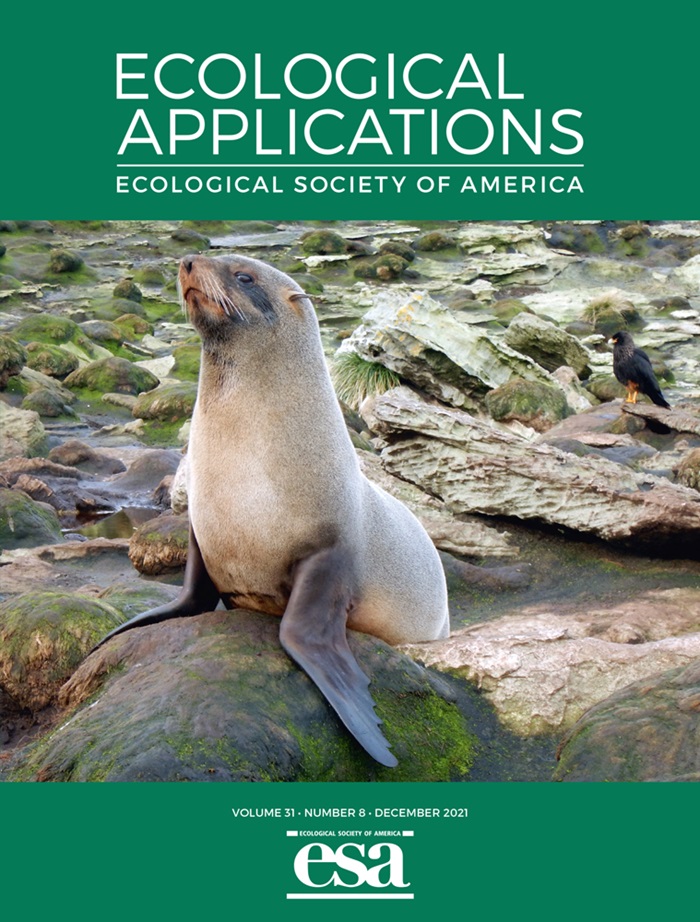Modeling cheatgrass distribution, abundance, and response to climate change as a function of soil microclimate
IF 4.3
2区 环境科学与生态学
Q1 ECOLOGY
引用次数: 0
Abstract
Exotic annual grass invasions in water‐limited systems cause degradation of native plant and animal communities and increased fire risk. The life history of invasive annual grasses allows for high sensitivity to interannual variability in weather. Current distribution and abundance models derived from remote sensing, however, provide only a coarse understanding of how species respond to weather, making it difficult to anticipate how climate change will affect vulnerability to invasion. Here, we derived germination covariates (rate sums) from mechanistic germination and soil microclimate models to quantify the favorability of soil microclimate for cheatgrass (作为土壤小气候的函数模拟骗子草的分布、丰度和对气候变化的反应
外来一年生草入侵限水系统会导致本地动植物群落退化,并增加火灾风险。外来入侵一年生草的生活史对天气的年际变化非常敏感。然而,目前的遥感分布和丰度模型只能粗略地了解物种对天气的反应,因此很难预测气候变化将如何影响入侵的脆弱性。在这里,我们从机理萌芽和土壤微气候模型中得出了萌芽协变量(速率和),以量化土壤微气候对美国西部鼠尾草干草原系统 2662 个地点 30 年间 cheatgrass(Bromus tectorum L.)建立和生长的有利程度。我们的方法仅使用了四个生物气候协变量,就预测出了车轴草的分布,其准确性可与之前使用多年遥感图像拟合的模型相媲美。样本外测试数据集的准确度指标表明,我们的模型对分布的预测很好(总体准确度为72%),但对丰度模式的解释较差(R2 = 0.22)。气候是否适合牧草的存在取决于秋季和春季速率总和的空间(平均值)和时间(年度异常值)变化。平均而言,秋季土壤温暖湿润、春季土壤温暖湿润(这两个时期的比率总和较高)的地点预计会有较多的 cheatgrass。与春季土壤条件相比,秋季土壤条件的年际变化对 cheatgrass 的存在和丰度影响更大。根据我们的模型预测,气候变化已经影响到车轴草的分布,从1989年到2019年,在中低海拔地点,适宜的小气候条件在各个方面都扩大了10%-17%,而高海拔地点(>2100米)由于春季和秋季土壤寒冷,仍然不利于车轴草的生长。
本文章由计算机程序翻译,如有差异,请以英文原文为准。
求助全文
约1分钟内获得全文
求助全文
来源期刊

Ecological Applications
环境科学-环境科学
CiteScore
9.50
自引率
2.00%
发文量
268
审稿时长
6 months
期刊介绍:
The pages of Ecological Applications are open to research and discussion papers that integrate ecological science and concepts with their application and implications. Of special interest are papers that develop the basic scientific principles on which environmental decision-making should rest, and those that discuss the application of ecological concepts to environmental problem solving, policy, and management. Papers that deal explicitly with policy matters are welcome. Interdisciplinary approaches are encouraged, as are short communications on emerging environmental challenges.
 求助内容:
求助内容: 应助结果提醒方式:
应助结果提醒方式:


